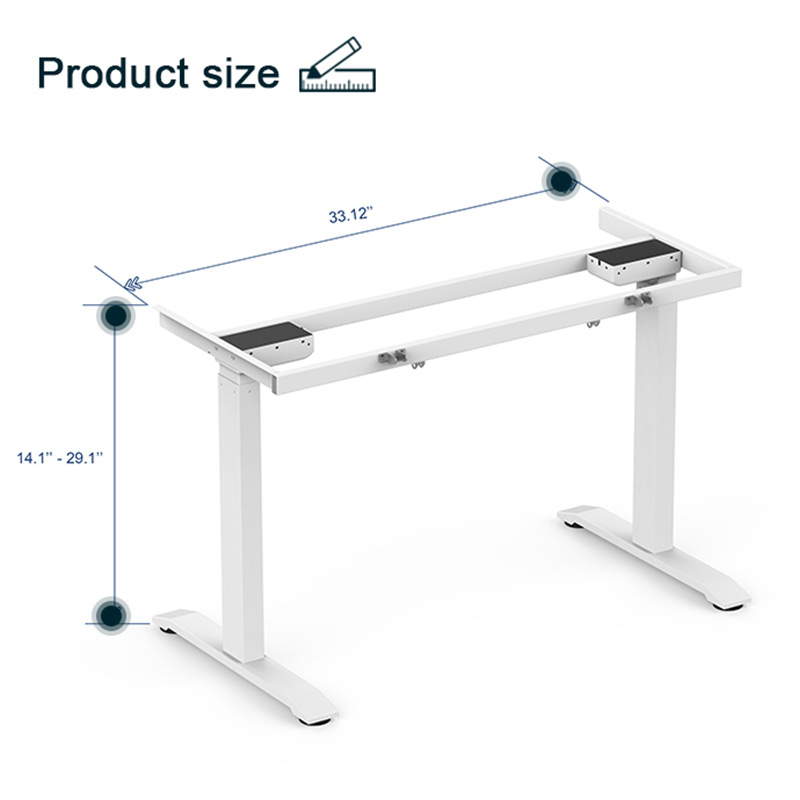Introduction
In recent years, the standing desk has become a popular fixture in home and office spaces worldwide, and for good reason. As the sedentary lifestyle becomes increasingly linked to various health issues, standing desks offer a practical solution to increase daily physical activity. Beyond the health benefits, standing desks have been shown to boost productivity and improve focus, making them an attractive investment for individuals and businesses alike. But with so many options on the market, how do you choose the right standing desk frame for your needs? This comprehensive guide will walk you through the benefits, key considerations, and types of standing desk frames to help you make an informed decision.

I. The Benefits of Standing Desk Frames
Electric Drawing Desk with Large Side Board Tiltable TabletopStanding desk frames are the backbone of an active workspace, offering a range of health and productivity benefits:
 Health Benefits
Health Benefits
- Reduced Risk of Obesity: Standing burns more calories than sitting, which can contribute to weight management.
- Improved Blood Sugar Levels: Studies suggest that standing can help regulate blood sugar levels, beneficial for individuals with diabetes.
- Lower Risk of Heart Disease: Prolonged sitting has been linked to heart disease. Standing desks encourage movement, reducing this risk.
Improved Posture and Reduced Back Pain
Sitting for extended periods can lead to slouching and poor posture, which may result in chronic back pain. Standing desk frames allow for regular posture changes, promoting better spinal alignment and reducing discomfort.
Enhanced Productivity and Work Engagement
Standing has been shown to increase mental acuity and focus, leading to a more productive work session. Additionally, switching between sitting and standing can help prevent the afternoon slump, maintaining consistent work engagement throughout the day.
II. Key Factors to Consider When Choosing a Standing Desk Frame
Selecting the right standing desk frame involves careful consideration of several key factors:
Size and Weight Capacity

Ensure the frame is the appropriate size for your workspace and can support the weight of your desktop and equipment. Consider both the frame’s dimensions and its load-bearing capacity.
Adjustability
Look for a frame that allows for smooth and easy height adjustment. This feature is crucial for finding the perfect standing height and quickly switching between sitting and standing throughout the day.
Material and Construction
Choose a frame made from high-quality, durable materials. A well-constructed frame will last longer and provide a stable surface for your workspace.
Design and Aesthetics
Consider the frame’s design and how it will fit into your existing office decor. Aesthetics may include the frame’s color, finish, and overall style.
Compatibility
Ensure the frame is compatible with your existing or planned desktop. This factor is essential if you already have a desktop you wish to use or have specific requirements for the desktop material or size.
Price and Budget
Determine your budget and find a frame that offers the best value for money. Keep in mind that investing in a high-quality frame can save you from needing to replace it frequently, providing long-term value.
By understanding the benefits and considering the key factors when choosing a standing desk frame, you can create a workspace that supports both your health and productivity. In the next section, we’ll explore the different types of standing desk frames available to you.
III. Types of Standing Desk Frames
When it comes to standing desk frames, there are primarily two types that cater to different needs and spaces: single-leg and dual-leg frames.
 Single-Leg Frames
Single-Leg Frames
- Single-leg frames, also known as cantilever frames, feature a single support structure that extends from the ground to the desktop.
- They are popular for their sleek, minimalist design and are ideal for smaller spaces where a clutter-free look is desired.
- These frames can offer a good balance of stability and adjustability, making them suitable for users of varying heights.
Dual-Leg Frames
- Dual-leg frames, or two-post frames, consist of two vertical supports on each side of the desk.
- They are known for their robust stability and weight capacity, making them perfect for heavy-duty use or for holding larger desktops.
- The dual-leg design also allows for a wider range of motion during height adjustments, which can be beneficial for shared workspaces.
When choosing between these two types, consider the size of your workspace, the weight of your desktop, and your personal aesthetic preferences. Single-leg frames are often more visually appealing in smaller spaces, while dual-leg frames provide unparalleled stability for heavy use.
IV. How to Choose the Right Standing Desk Frame
Selecting the right standing desk frame is a personalized decision, but here’s a guide to help you through the process:
- Determine Your Workspace Dimensions
Measure your available space and the footprint of your desktop to ensure the frame will fit comfortably.
- Assess Your Height Range
Consider your height and the height of your workspace to determine the appropriate height adjustment range for your frame.
- Evaluate Your Equipment Weight
Take into account the weight of your monitor, computer, and other peripherals to select a frame with adequate weight capacity.
- Consider Your Budget
Establish a budget and look for frames that offer the best combination of quality, durability, and features within that price range.
- Think About Aesthetics
Choose a frame that complements your existing office decor or the desired aesthetic of your workspace.
- Check for Additional Features
Look for features such as cable management systems, built-in USB ports, or adjustable leveling feet that can enhance your workspace functionality.
- Read Reviews and Compare Models
Research different models and read user reviews to gain insights into the performance and durability of various standing desk frames.
- Consider the Warranty and Customer Support
A good warranty and responsive customer support can give you peace of mind and protect your investment.
By taking a thoughtful approach to choosing your standing desk frame, you can create a workspace that not only supports your health but also meets your specific needs and preferences. In the next section, we’ll discuss the assembly and setup process to ensure your new standing desk frame is ready for use.
Conclusion
In summary, selecting the appropriate standing desk frame is a personal decision that should reflect your health needs, workspace dimensions, and budget. By considering the size, adjustability, material, design, compatibility, and price, you can find a frame that not only improves your ergonomics but also enhances your productivity. Investing in a standing desk frame is an investment in your well-being and work quality, so choose wisely to create a workspace that adapts to your active lifestyle.
FAQ
Here are some answers to frequently asked questions about standing desk frames:
- What is the difference between a single-leg and dual-leg frame?
Single-leg frames are known for their clean, minimalist look and are suitable for smaller spaces and lighter loads. Dual-leg frames offer greater stability and can support heavier loads, making them ideal for larger workspaces and shared environments.
- How do I know what size frame I need?
Measure your workspace and consider the dimensions of your desktop. Ensure the frame’s adjustability range accommodates your height and the height of your workspace.
- What is the average weight capacity for standing desk frames?
Weight capacity varies by model, but a good standing desk frame should be able to support at least 100 pounds. Heavier-duty frames can support 300 pounds or more.
- Do I need a motorized or manual adjustment mechanism?
Motorized frames offer effortless height adjustments with the press of a button, while manual frames require you to lift the desktop. Consider your budget and the convenience you desire.
- How do I maintain my standing desk frame?
Regularly clean the frame, avoid overloading it, and check for any signs of wear or damage. Ensure all bolts and screws are tight to maintain stability.
- What is the best material for a standing desk frame?
Steel is a popular choice for its strength and durability. Other materials like aluminum can be lightweight and strong, while wooden frames offer a natural aesthetic.
- Can I use my existing desktop with a new frame?
It depends on the frame’s compatibility. Some frames are designed to accommodate a wide range of desktop sizes and shapes, while others may require a specific desktop.
- How do I assemble a standing desk frame?
Most frames come with instructions and necessary hardware for assembly. Follow the steps carefully, and if needed, seek guidance from online resources or videos.
- What is the average cost of a standing desk frame?
Prices can range from $100 for basic models to over $500 for high-end, motorized frames with advanced features.
- Where can I find the best deals on standing desk frames?
Look for sales at office supply stores, furniture retailers, or online marketplaces. Reading reviews and comparing prices can help you find the best deal.


